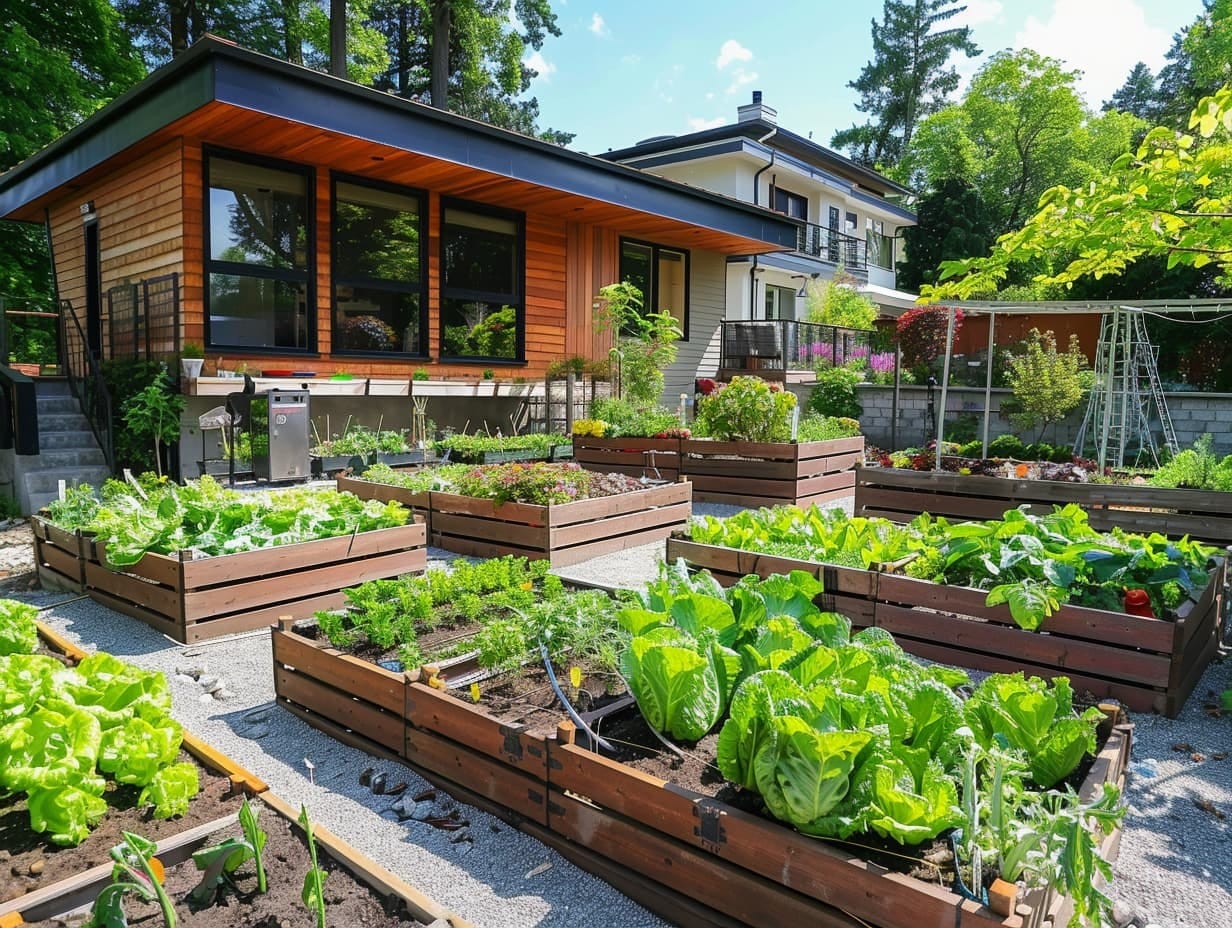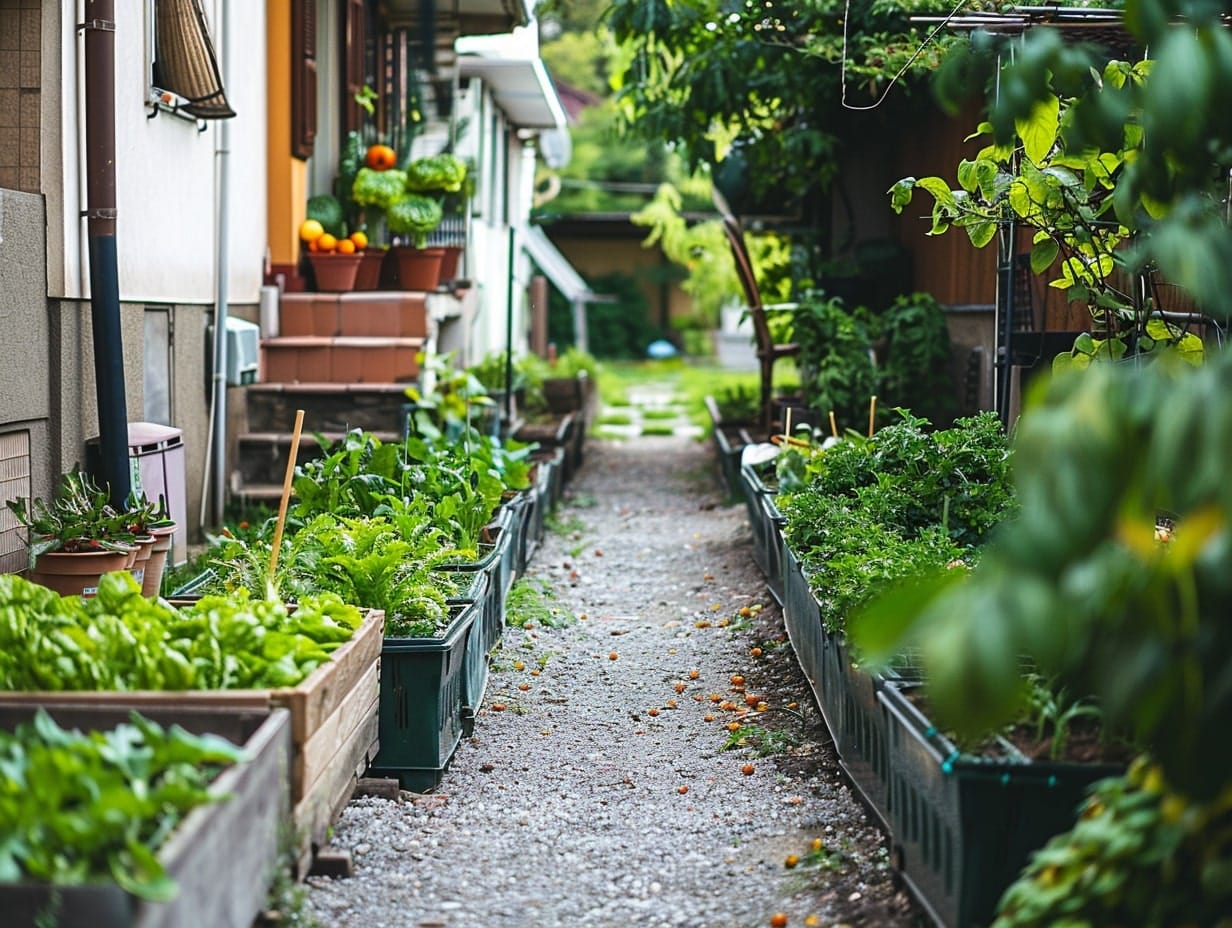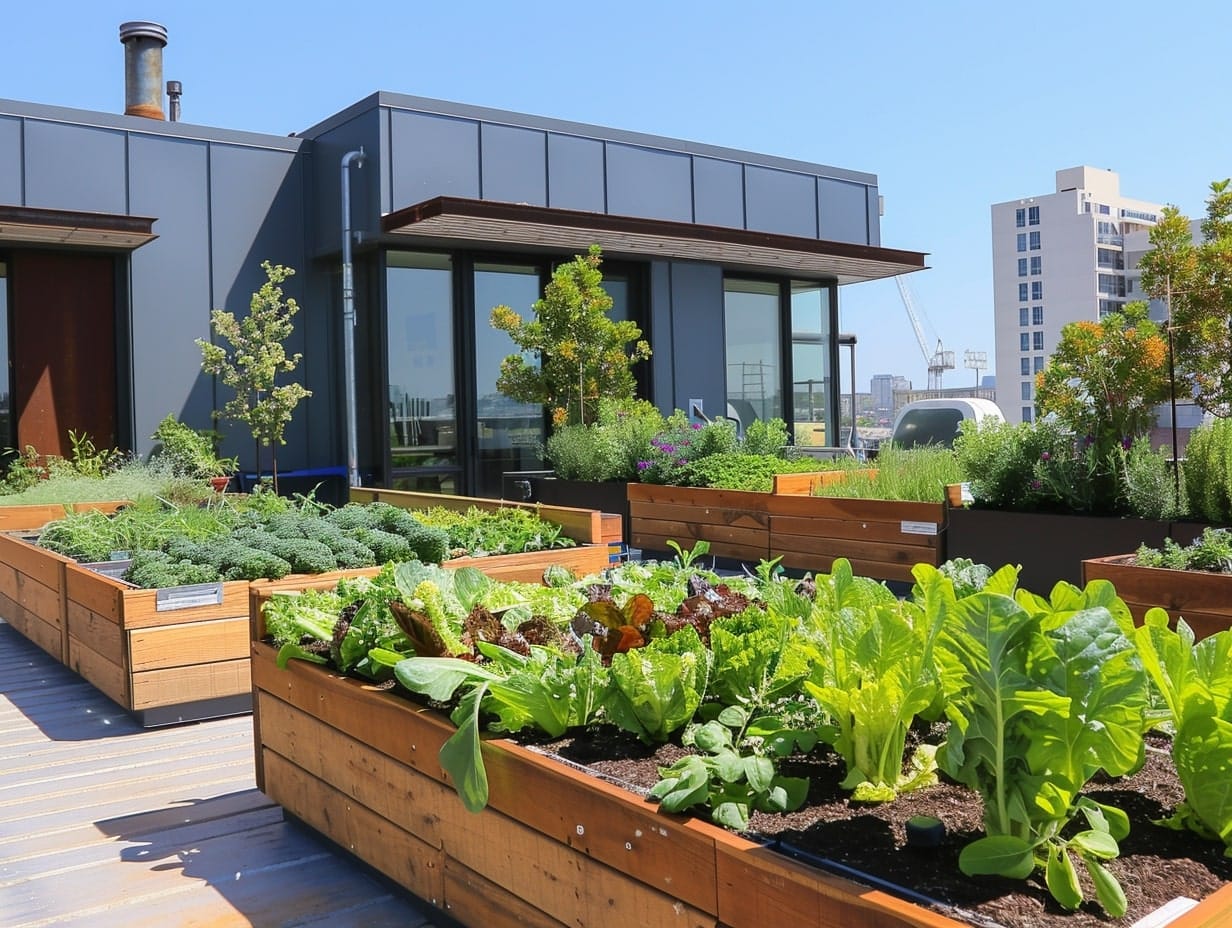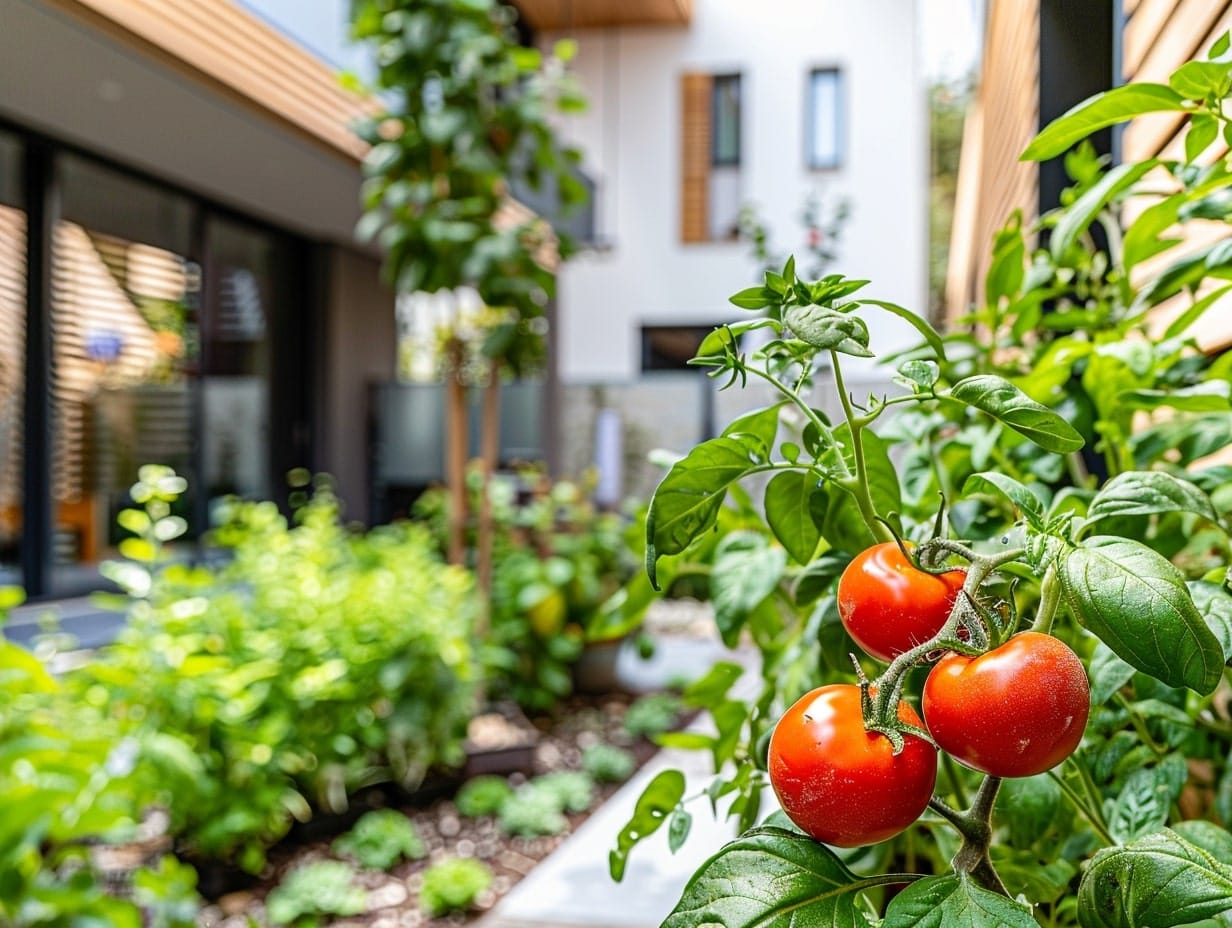When you buy products via links on our website, we might receive an affiliate commission. Learn more
14 Vegetable Garden Ideas and Layouts for Your Yard

Enhance your vegetable garden with 14 innovative layouts that maximize space, improve yield, and add visual appeal. From traditional straight rows to modern vertical gardens, these ideas cater to various styles and spaces.
Learn to layout gardens with evenly spaced rows, build raised beds for better drainage, and implement efficient square foot gardening. Discover the charm of a potager garden, the practicality of container gardening, and the benefits of rotating crops and companion planting.
Transform your vegetable garden into a productive and beautiful area in your yard with our comprehensive guide.
Layout the Garden in Straight, Evenly Spaced Rows

This traditional approach to gardening maximizes space efficiency and simplifies the management of crops. By arranging your garden in straight, evenly spaced rows, you facilitate easier planting, watering, and harvesting.
Dedicate each row to a single type of vegetable for systematic crop rotation and straightforward maintenance.
Ensure paths between the rows are wide enough to comfortably walk through and accommodate garden equipment, such as wheelbarrows or tillers. This layout promotes good air circulation, which reduces the risk of plant diseases.
Build Raised Beds to Improve Soil Drainage

Building raised beds is an effective gardening strategy that enhances soil drainage, crucial for healthy plant growth. Elevated above ground level, these beds ensure water doesn't pool around plant roots, preventing issues like root rot.
Constructed from materials such as wood, stone, or cinder blocks, raised beds can be filled with a tailored soil mix, providing optimal conditions for vegetables. This setup not only improves soil warmth, speeding up early growth, but also facilitates deeper root development.
The contained nature of raised beds makes them easier to manage, reduces soil compaction from foot traffic, and helps deter some pests.
Implement Square Foot Gardening

Square foot gardening optimizes space by dividing the garden into small square sections, typically 1x1 foot each, within a grid layout. This method is highly efficient, reducing the need for aisle space and focusing on growing area.
Plant each square with a specific number of plants, depending on their size. For example, one tomato plant per square, four lettuce plants, or sixteen radishes. This layout promotes high yields and variety in a compact space.
It also simplifies tasks like planting, weeding, and harvesting by making them manageable within each distinct square.
Design a Potager Garden With Fruit, Flowers, Vegetables and Herbs

This type of design integrates vegetables, fruits, herbs, and flowers in a harmonious layout that is both aesthetically pleasing and highly functional. The garden is usually structured with geometric patterns and often includes pathways, with beds laid out in formal designs like squares, rectangles, or even circles.
In each bed, you can feature a different grouping of plants that are selected for their complementary colors, textures, and heights.
For example, tall tomato plants might be surrounded by lower-growing marigolds and basil, which help repel pests and improve tomato health and flavor. Edible flowers such as nasturtiums and calendula add color and can be used in salads or as garnishes. Fruit bushes like blueberries add structural height and visual interest.
Grow Vertical Vegetable Gardens

This method involves growing plants upward instead of outward, using structures like trellises, towers, wall planters, or hanging baskets. Vertical gardens are ideal for climbing vegetables such as beans, peas, and cucumbers, as well as vining crops like tomatoes and squash.
Leafy greens, herbs, and smaller plants can be cultivated in wall-mounted planters, providing easy access and efficient use of space. This layout not only enhances the aesthetic appeal of a garden area but also improves air circulation around the plants, reducing the risk of fungal diseases.
Use Container Gardening to Grow Vegetables

This method involves planting vegetables in containers such as pots, buckets, window boxes, or even recycled items like old barrels or fabric grow bags. Container gardening allows for precise control over soil quality and moisture levels, which is crucial for healthy vegetable growth.
It’s ideal for plants that require specific soil types or pH levels. You can arrange the containers aesthetically and move them to optimize sunlight exposure throughout the season.
Organize the Garden in a Circular, Mandala Pattern for Both Beauty and Yield

A Mandala garden is designed in a circular pattern, inspired by the spiritual symbols of Hinduism and Buddhism that represent the universe.
Suitable for diverse plant types, a Mandala garden can incorporate various herbs, vegetables, fruits, and beneficial flowers, creating a biodiverse environment that attracts pollinators and beneficial insects.
Dedicate a Perennial Vegetables Area

Perennials such as asparagus, rhubarb, artichokes, and some types of onions and garlic, once established, return year after year, reducing the need for annual replanting.
Organize this section in a part of your garden that can remain undisturbed over long periods, ensuring these plants have the space to spread and mature.
This area should have well-drained, fertile soil and adequate sunlight. Mulch around the perennials to retain soil moisture and suppress weeds, further minimizing maintenance efforts while ensuring a reliable, yearly harvest.
Organize the Vegetables by Color for an Eye-Catching Look

Organizing your vegetable garden by color creates a vibrant and visually appealing space. Arrange plants in sections based on their primary colors — greens, reds, purples, yellows, and oranges.
For example, plant leafy greens like lettuce, kale, and spinach together. Dedicate another area to red vegetables such as tomatoes, radishes, and red peppers.
Group purple vegetables like eggplants and purple cabbage in another section, and place yellow and orange vegetables like squash, carrots, and bell peppers together.
Divide the Garden Into Sections for Rotating Crops Like Leafy Greens, Fruits, Roots and Legumes

Divide your garden into four distinct sections, each dedicated to a different plant group: leafy greens, fruits, roots, and legumes. Rotate these groups annually to maintain soil health and prevent pest and disease buildup.
In Section 1, plant leafy greens such as spinach, lettuce, kale, and cabbage. Section 2 is dedicated to fruits, where you can grow tomatoes, peppers, cucumbers, and squash.
In Section 3, include root vegetables like carrots, beets, radishes, and potatoes. Finally, in Section 4, cultivate legumes such as beans, peas, and lentils.
Grow a Rooftop Vegetable Garden

Start by ensuring the roof can support the weight of soil, plants, and water. Use lightweight, well-draining containers or raised beds with a high-quality potting mix to reduce weight.
Arrange plants based on sunlight requirements, with sun-loving vegetables like tomatoes, peppers, and cucumbers in the sunniest spots, and partial shade-tolerant greens like lettuce, spinach, and herbs in shaded areas.
Apply Companion Planting to Enhance Growth and Deter Pests

Pair plants with complementary benefits in the same bed. For instance, plant tomatoes alongside basil and marigolds. Basil improves tomato flavor and repels insects, while marigolds deter nematodes and other pests.
Grow carrots with onions or leeks; the onions' strong scent deters carrot flies, and carrots loosen the soil for onions.
Beans and corn are another great pairing; beans fix nitrogen in the soil, benefiting the corn, which provides support for the bean vines. Similarly, plant cabbage with dill to attract beneficial insects that prey on cabbage pests.
Design a Hanging Vegetable Garden

Start by selecting sturdy hanging containers or baskets with good drainage. Choose lightweight, compact vegetables like cherry tomatoes, lettuce, herbs, and strawberries, which thrive in hanging environments. Incorporate drip irrigation or self-watering pots to maintain consistent moisture levels.
Position cascading plants like trailing nasturtiums or peas on the edges for a lush, flowing effect. Regularly rotate containers to ensure even light distribution and prune plants to maintain air circulation.
Grow Vegetables in a Pallet to Save Space

Start by selecting a clean, untreated wooden pallet. Secure landscape fabric or burlap to the back and sides to hold soil in place. Fill the pallet with a high-quality potting mix, ensuring it’s firmly packed into each section.
Choose compact vegetables and herbs like lettuce, spinach, radishes, and basil, which thrive in the limited space of pallet slats. Plant seeds or seedlings in the soil-filled gaps, spacing them appropriately.
